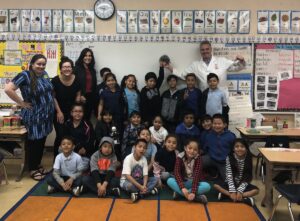 Expanding our Cancer Education Initiative: the Medical STEM Program
Expanding our Cancer Education Initiative: the Medical STEM Program
Originally Published June 18, 2019
One of our new initiatives for Spring 2019 has been the expansion of our Cancer Education Curriculum into the Medical STEM Program which includes additional after-school sites and an in-school program in three of our schools. This program was created in partnership with the USC Norris Comprehensive Cancer Center and aims to provide second grade students with hands-on, inquiry-based lessons that explore the biological and genetic basis of cancer, common and cutting-edge treatment technology, and the health risk factors associated with cancer. It was pioneered during Fall 2018 via our Wonderkids program and the Cancer Education after-school workshop presented at Weemes Elementary. Due to the program’s success, we were able to expand the program this Spring to include lessons during the school day at the Dr. Theodore T. Alexander Science Center School, Vermont Avenue Elementary and Lenicia B. Weemes Elementary in addition to offering the curriculum after school at Foshay Learning Center and 32nd St. USC Magnet.
The cancer education curriculum for Spring 2019 encompasses four units within the context of how they relate to cancer: Oncology, Nutrition, Genetics, and Biotechnology. All units in this curriculum run for two weeks over four instructional sessions and incorporate hands-on, inquiry-based activities to empower students to discover the science behind cancer and cancer treatment. Take for example our first unit which centered around the field of Oncology (the field of medicine dedicated to the study of tumors), in which the students were introduced to the concept and biology of cancer as a disease.


The first lesson assessed students’ prior knowledge of the word cancer, and its various meanings and connotations. Children responded to questions such as “when I hear the word cancer, I think of….” and drew pictures to reflect on how they feel, what they think or their concerns about cancer. Some common responses were “I think that it will happen to me and I feel scared”; “I know that cancer is scary.”; “ I want to be safe”; “I want to learn how to be safe.”; “Think about people that are sick.”; “I feel hope.”; “Some people lose their hair and have to go to the doctor.”; “I know that cancer is bad.”; and “How do you get cancer?”. These responses were utilized by instructors to help address the assumptions, misconceptions and negative connotations surrounding cancer and highlighting for students that in many cases, cancer can be treated.
Subsequent lessons in the unit were designed to introduce students to human cells, the number of cells in the human body, and how healthy and cancerous cell division (mitosis) works. The lesson dedicated to cell division focused on the context of growth and repair of living systems. Students were taught about the basic principles of cell division and the importance of this process in the onset and progression of cancer. The use of Play-Doh to create abstracted, spherical cell models made it easy for students to understand the process of mitosis and the differences between healthy and diseased cell division.
The final lesson in the Oncology unit allowed students to explore the various types of cancer and their respective anatomical origins in the human body. Student’s were able to visualize where different types of cancer occur and the parts of the body they impact through a “Pin the Tumor on the Organ” activity.
This implementation of the Medical STEM Program into the classroom setting has been a great success. Stacey Finnin, a second grade teacher at Weemes Elementary had this to say about the program: “The students have been engrossed and eager and willing to learn more about how cells change. As a teacher, it’s been amazing to see them retain the knowledge and build upon it with connections to other subjects and lessons.” This sentiment was echoed by Medical STEM Program TA Stephanie Davis: “The students love the hands-on experiments these lessons bring; building a gummy bear DNA model and using Play-Doh to show the process of cell division. It’s been rewarding to see the students having great retention from the beginning of the unit, freely bringing up concepts like cell division from unit 1 and relating it to our current genetics unit without me having to prompt them. I’m so happy to participate in a program that fosters an interest in science and health at such a young age.”

Program Director, DJ Kast, and Coordinator/Graduate Student, Anupam Singh, have been instrumental in facilitating the expansion of the program and increasing the impact of cancer education outreach among the student population we serve through Wonderkids. We would like to acknowledge our incredible classroom teachers: Mr. Kiessling, Ms. Robles, Ms. Finnin, Ms. Lemle for welcoming and supporting the program into their instructional time. This newly expanded program could not run without the work of our fabulous instructors: Emma Case, Stephanie Davis, Sarah Sanchez, and Ginger Dudley. Dr. W. Martin Kast and Anupam Singh were guest scientists who spoke to the students about their careers in STEM (Science, Technology, Engineering, and Mathematics).